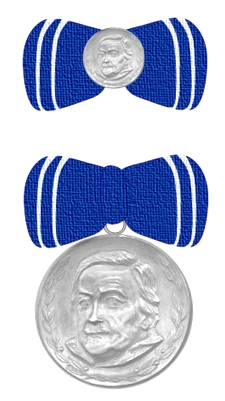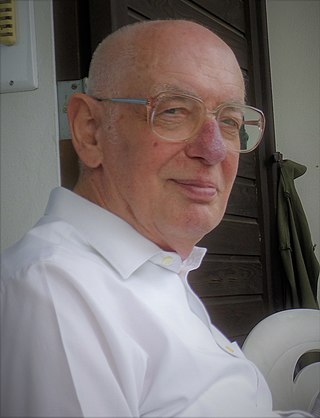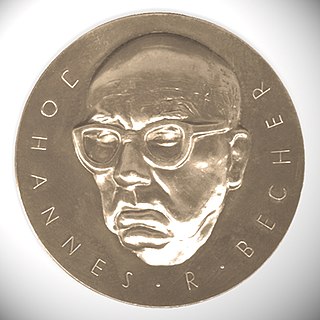
The Volksmarine was the naval force of the German Democratic Republic (GDR) from 1956 to 1990. The Volksmarine was one of the service branches of the National People's Army and primarily performed a coastal defence role along the GDR's Baltic Sea coastline and territorial waters.
The National Prize of the German Democratic Republic (East Germany) (German: Nationalpreis der Deutschen Demokratischen Republik) was an award of the German Democratic Republic (GDR) given out in three different classes for scientific, artistic, and other meritorious achievement. With scientific achievements, it was often given to entire research groups rather than individual scientists.

Heinz Hoffmann was Minister of National Defense in the Council of Ministers of the German Democratic Republic, and since 2 October 1973 member of the Politburo of the Central Committee of the Socialist Unity Party (SED).
Job-Wilhelm Henning Dietrich von Witzleben was a German army officer and a military historian.

The Medal for Exemplary Border Service was a national award issued in the German Democratic Republic (GDR). It was established on 28 May 1954, by the Council of Ministers of the GDR with Order No. 47/54 from the Ministry of Interior on 16 June 1954. The first presentation ceremony took place on 1 July 1954, to members of the German Border Police.

Günter Kochan was a German composer. He studied with Boris Blacher and was a master student for composition with Hanns Eisler. From 1967 until his retirement in 1991, he worked as professor for musical composition at the Hochschule für Musik "Hanns Eisler". He taught master classes in composition at the Academy of Music and the Academy of Arts, Berlin. He was also secretary of the Music Section of the Academy of Arts from 1972 to 1974 and vice-president of the Association of Composers and Musicologists of the GDR from 1977 to 1982. Kochan is one of eleven laureates to have been awarded the National Prize of the GDR four times. In addition, he received composition prizes in the US and Eastern Europe. He became internationally known in particular for his Symphonies as well as the cantata Die Asche von Birkenau (1965) and his Music for Orchestra No. 2 (1987). His versatile oeuvre included orchestral works, chamber music, choral works, mass songs and film music and is situated between socialist realism and avant-garde.

The Heinrich Greif Prize was an East German state award bestowed on individuals for contribution to the state's cinema and television industry.
Ilko-Sascha Kowalczuk is a German historian and author. His work is focused on the German Democratic Republic and its Ministry for State Security.

The Clara Zetkin Medal was a national award in the German Democratic Republic.
Horst Bartel was a German historian and university professor. He was involved in most of the core historiography projects undertaken in the German Democratic Republic (1949–1989). His work on the nineteenth-century German Labour movement places him firmly in the mainstream tradition of Marxist–Leninist historical interpretation.

Lieselott Herforth was a German physicist and politician. She was a member of the State Council and the People's Chamber of the GDR and she was the first rector of a university in Germany.

Peter Heinz Feist was a German art historian.
Wolfgang Lesser was a German composer and music official of the DDR.

The Johannes-R.-Becher-Medaille was a civil decoration of East Germany created in homage to the poet and politician Johannes R. Becher. It was awarded by the Cultural Association of the GDR.
Walter Draeger was a German composer and music educator. Er war Professor an der Staatliche Hochschule für Theater und Musik Halle and the Hochschule für Musik Franz Liszt, Weimar. In 1955, war er Mitinitiator der ersten Hallische Musiktage.
Werner Felix was a German music historian and Bach scholar. He was rector of the Hochschule für Musik Franz Liszt, Weimar and the University of Music and Theatre Leipzig as well as president of the Chopin-Gesellschaft of the DDR.
Andre Asriel was an Austrian-German composer.

Inner German relations, also known as the FRG-GDR relations, East Germany-West Germanyrelations or German-German relations, were the political, diplomatic, economic, cultural and personal contacts between the Federal Republic of Germany and the German Democratic Republic, at the period of the West-East division in German history from the founding of East Germany on 7 October 1949 to Germany's reunification on 3 October 1990.

Hero of the German Democratic Republic (GDR) was an honorific title awarded by the former East German state, accompanied by a certificate and medal. The title was instituted by the politburo of the Socialist Unity Party on 29 October 1975 as the most prestigious award of the GDR and first awarded on 28 November 1975. In total, it was awarded on 17 occasions to 11 recipients.

Martha Israel was a German clerk and politician of Sorbian ethnicity. She served in the Volkskammer of East Germany from 1963 until 1967 as a member of the Socialist Unity Party and the Democratic Women's League of Germany. Prior to this, she was also a member of the Spremberg city council, and was the secretary of the local branch of the Domowina.












